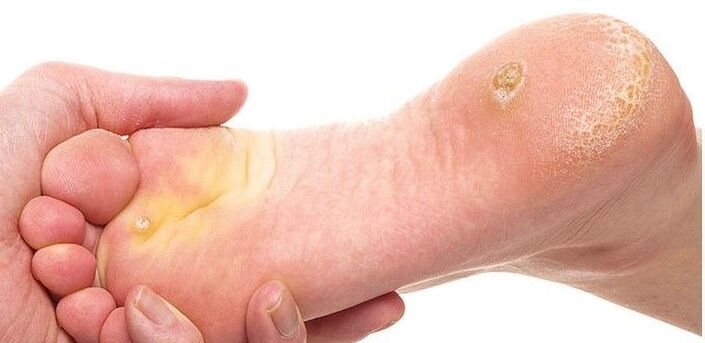
A plantar or spinal wart is one of the most unpleasant types of skin growth. This formation is located on the supporting part of the foot or toes. It consists of overgrown epithelial cells and has a deep root that extends deep into the dermis.
Pimples do not pose a particular danger in terms of oncogenicity, but they can be extremely painful and cause significant discomfort when walking. These growths are difficult to treat and are characterized by a tendency to relapse. How to get rid of a plantar wart, which methods are considered to be the most effective and safest? Find out more about this in our article.
Why do thorns appear?
Warts on the feet are benign neoplasms of a viral nature. The cause of its appearance is the infection by HPV (papiloma virus). The pathogen is transmitted from person to person by contact or reaches the skin when it comes in contact with an infected surface. It's great in a hot, humid environment where it can be stored for a long time. The risk of infection is especially high in public places - baths, saunas, gyms, swimming pools. The virus easily enters the body through small abrasions or scratches on the skin.
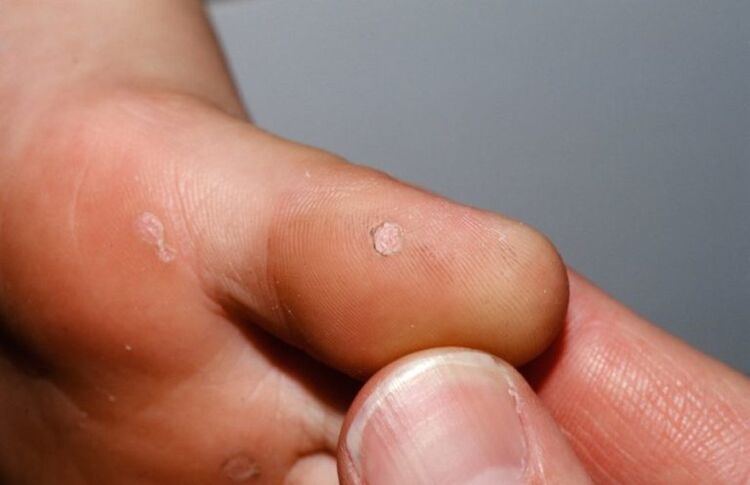
A strong immune system suppresses the virus from multiplying and puts it into a latent state. But as soon as the body's defenses weaken, the pathogen is activated and begins to multiply rapidly. Recent illnesses, stress, violation of personal hygiene standards become provocative factors that weaken the immune defense. The following factors contribute to the formation of plantar warts:
- excessive sweating of the feet;
- wear tight, uncomfortable shoes;
- skin microtrauma (bruises, scratches, wounds, abrasions);
- frequent contact with water and detergents that cause skin dryness;
- chronic diseases associated with decreased blood circulation in the lower extremities (diabetes mellitus, atherosclerosis, varicose veins);
- foot deformities (flat feet, small joint arthritis, osteoarthritis);
- constant formation of calluses, calluses.
Plantar warts can be found by wearing the shoes of an infected person or by visiting a pedicure salon where utensils are poorly disinfected. A plantar wart on a child usually forms after visiting a swimming pool, summer camp, public shower, where the baby may mistakenly put on someone else's shoes, walk barefoot on a dirty surface, or use the carrier's personal belongings. ( towel, face cloth, etc. ). Parents should teach their baby to observe personal hygiene guidelines as early as possible and explain why it is impossible to use other people's things.
What does a plantar wart look like?
The incubation period, during which the papilloma virus multiplies, is quite long - from 1, 5 to 4 months. First, the pathogen affects the basal layer of the epidermis, then it spreads upward, leading to the formation of characteristic bumps on the skin.
Initially, a wart on the foot of a child or adult looks like a shiny, round-shaped plaque with a small diameter (up to 2 cm). Soon its surface becomes rough, covered by a dense stratum corneum, which rises above the surface of the skin. The spine color changes from flesh to yellowish gray. A crater-shaped depression appears in the center of the neoplasm. On closer examination, black dots are visible on the surface of the wart. They are thrombosed capillaries that come out to the surface. The presence of this feature allows distinguishing a plantar wart from calluses or calluses. A photo of a plantar wart gives a complete picture of what this formation looks like on the skin.
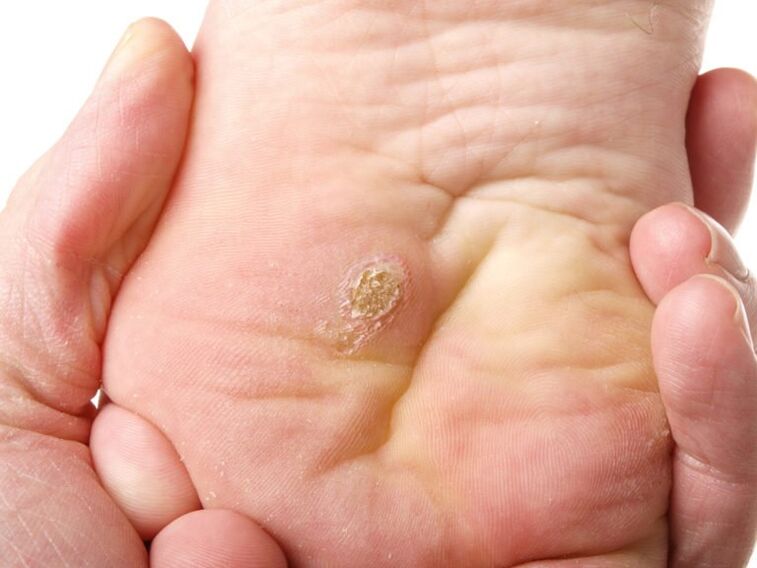
A favorite location for the spinal column is the area of the foot that is subjected to the most pressure. The root of the neoplasm penetrates deep into the dermis, irritates the nerve endings, so these warts cause painful sensations when walking. The growths on the soles are single and multiple. A large maternal wart usually appears on the foot first. If the virus is highly active, then small daughter formations will form alongside it. Sometimes the spine disappears on its own, but more often the constant injury leads to its growth and the appearance of severe pain due to the constant pressure of the shoe.
How to get rid of warts on the feet if these formations are painful and cause great discomfort? First, you need to contact a dermatologist for examination and treatment. Plantar warts are not easy to treat as they grow deep in the dermis. To prevent the reappearance of the pimples, the root of the neoplasm must be completely removed. This can be done in different ways - medical and surgical.
Plantar Warts: Treatment
There are several methods for dealing with plantar warts. At home, pharmaceuticals can be used to treat warts on the feet. The physician must select the therapeutic regimen, as a positive effect can only be achieved with a correct and competent approach.
drug therapy
For the treatment of plantar warts at home, several methods are used - from the destruction by aggressive chemicals (acids, alkalis) to the freezing of pathological tissues with special means. To exclude relapses, it is necessary not only to remove the growth, but also to suppress the virus's activity.
The complex treatment is based on the following groups of drugs:
- Antiviral agents and immunomodulators.A cream that activates local immunity and inhibits virus multiplication has a good therapeutic effect. Must be applied twice a day under dressing. For the same purpose, a cream that stimulates interferon production is used.
- Keratolytic agents.Preparations based on salicylic acid or trichloroacetic acid are designed to soften and exfoliate the rough stratum corneum of the wart. The removal of dead scales allows reaching the base of the wart and facilitating the penetration of cauterizing or necrotizing solutions at its root. Only in this way is it possible to prevent the reappearance of new formations and get rid of pimples forever.
- Necrotizing drugs.To combat plantar warts, it is recommended to buy solutions based on acids or alkalis with a mummifying effect at the pharmacy. By penetrating the structure of the neoplasm, the aggressive substances burn the infected tissue, resulting in necrosis and death of the wart. When using these medications, precautions must be taken, otherwise you may cause chemical burns to healthy skin. Treatment of a plantar wart in a child with necrotic agents is permitted only after consultation with a dermatologist.
- Cryopreparations. . . The principle of action of such funds is based on the freezing of the wart tissue. Under the influence of ultra-low temperatures, the liquid inside the pathological cells freezes and breaks them down from the inside. As a result, the wart dies in 7 to 10 days. The best products with a freezing effect are produced in aerosol cans equipped with a special applicator for application.
The procedure should be started after consulting a dermatologist. Only a specialist can properly assess the situation and advise how to get rid of a plantar wart at home. Self-medication often leads to a short-term effect and repeated relapses, as it is not possible to prevent the spread of the virus.
Plantar Warts in a Child
The treatment of warts on a child's feet is done with gentle methods. Children's skin is delicate and thin, so aggressive products can cause irritation or burns. It is better to use drugs with a keratolytic action, which smooth and exfoliate the horny scales. This method of treatment is not quick - it takes 2-3 weeks to remove the wart.
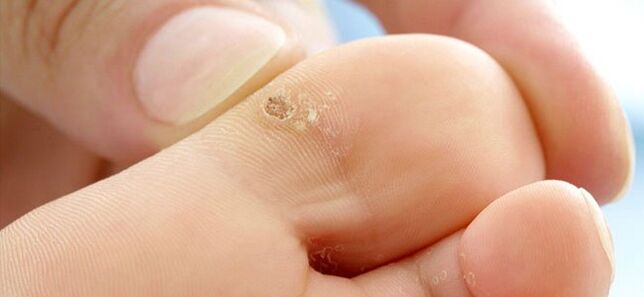
It is necessary to start using keratolytics in the early stages of neoplasm formation. In this case, it is possible to prevent the accumulation from reappearing. If the spine has grown deeply, you will have to resort to hardware treatment methods that deliver the desired result and guarantee no relapse.
If the plantar wart doesn't cause much concern, you can treat it with folk remedies - acetic acid solution, lemon juice, garlic tincture. An acidic environment has a destructive effect on the virus, interrupts its reproduction and prevents the growth of tumors.
Surgery
The classic operation with the use of a scalpel is rarely used. Such intervention is allowed only in the removal of large tumors, which cannot be eliminated by other methods. Surgery is performed under local anesthesia. The surgeon removes the wart and thoroughly cleans the wound, trying to completely remove the deep root. Disadvantages of the method include pain, the risk of wound infection and the subsequent development of complications, a long recovery period, during which a person has limited mobility.
It is best to remove plantar warts using hardware techniques that are less traumatic and safe. Referral for the procedure is made by the physician after a preliminary examination and identification of possible contraindications. The main treatment options are:
electrocoagulation
The essence of the method is to cauterize the tissue from the accumulation with a high-frequency electrical current. The procedure is performed using local anesthesia as it is accompanied by painful sensations. This option is only suitable for removing medium-sized spines with superficial germination deep in the dermis. If large formations are cauterized, the risk of scarring and repeated recurrences is not excluded.
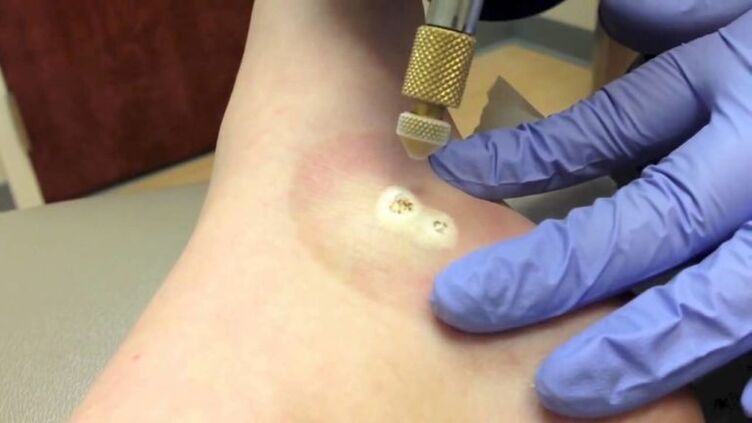
The rehabilitation period after electrocoagulation is quite long, requiring treatment of the wound with antiseptic solutions, excluding infection. During the recovery process, the patient has limited movement, as the load on the foot causes painful sensations.
cryodestruction
This is one of the most popular and affordable methods for treating plantar warts. The procedure takes just a few minutes and consists of treating the neoplasm with liquid nitrogen. The ultra-low temperature provides an instant freezing effect. The frozen fluid breaks the pathological neoplasm cells from the inside - as a result, the wart undergoes necrosis and dies within 10 days.
During the session, the doctor presses the applicator with the soda over the neoplasm for a few seconds, pre-protecting the surrounding healthy tissue. The effectiveness of the procedure is evidenced by the whitening of the skin in the treated area. Soon, a blister forms at the site of the wart, which should not be touched or punctured. It is recommended to cover it with a plaster to avoid injury. After a few days, the blister will dry out and a scab will form in its place. After falling off, renewed and healthy skin remains at the wart site.
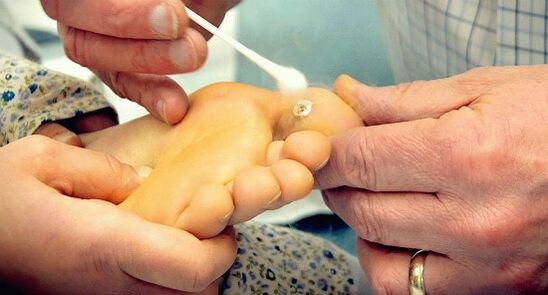
The procedure should only be performed by an experienced technician. Excessive exposure time causes deep tissue damage, followed by scarring, and overexposure does not destroy the root of the wart, which will lead to new growths.
laser removal
The modern procedure gives the best aesthetic result, allows you to control the depth of exposure, eliminates the risk of complications. Laser radiation evaporates the wart tissue layer by layer, simultaneously coagulating blood vessels and disinfecting the operative field. This effect eliminates the risk of bleeding, infections, guarantees the absence of recurrences, as it prevents the spread of viral particles. Different types of laser are used to remove warts - erbium, acid or pulsed.
The laser procedure is safe, effective and painless and does not require a long recovery period. At the site of the removed wart, a small wound remains, which is sealed with a cast. After the procedure, the patient can immediately go home and lead a normal life. The rehabilitation period is very short - complete healing takes just a few days.
Removal with radio knife
The essence of the latest technique is the use of radio waves, which allow the removal of plantar warts in the quickest and safest way. Powerful heat radiation burns the buildup without direct contact with surrounding tissue. The fluid in the cells of the neoplasm evaporates instantly, which causes the wart to be destroyed. At the same time, healthy skin is not damaged; during the procedure, the physician adjusts the depth and duration of exposure. At the same time, high-frequency radio waves disinfect the surgical field and cauterize blood vessels, eliminating the risk of bleeding.

Which plantar wart treatment method to choose, the patient decides together with the treating physician. Before scheduling the procedure, the dermatologist discovers possible contraindications.
A list of restrictions on using any hardware methods:
- inflammatory processes in the skin in the treatment area;
- diabetes;
- respiratory infectious diseases (ARVI, ARI);
- hypertension;
- exacerbation of herpesvirus infection;
- pregnancy.
The issue of using braces methods in relation to the child is discussed with the doctor. Some procedures are age-restricted, so you must know in advance all the nuances of the proposed methods and make sure there is no harm to the baby's health.























